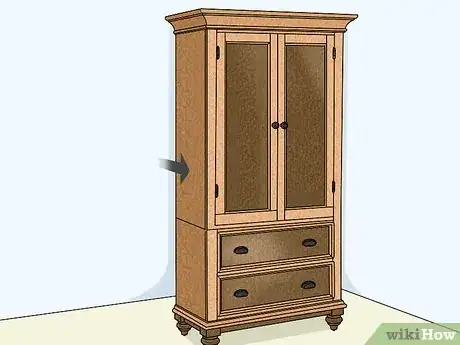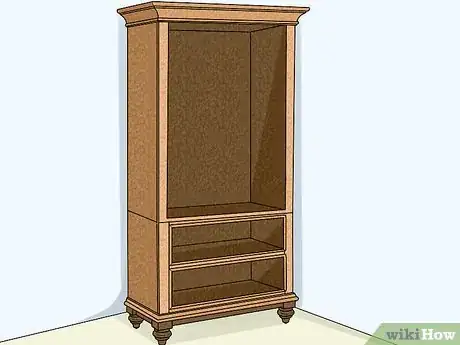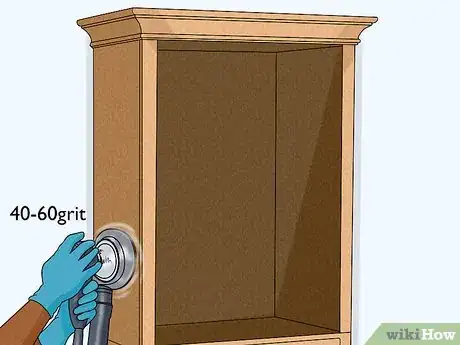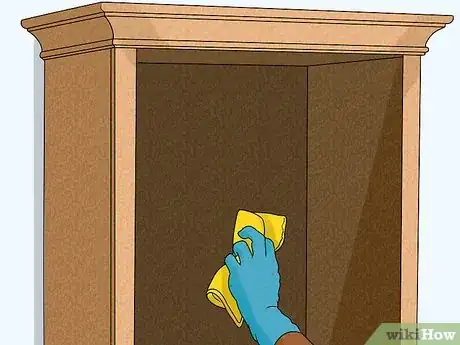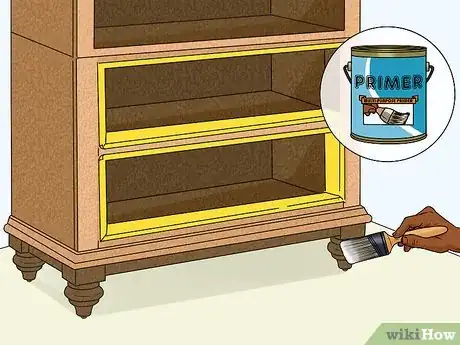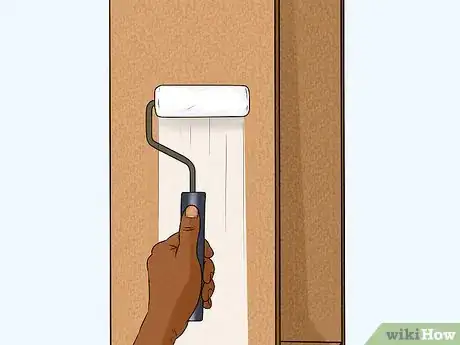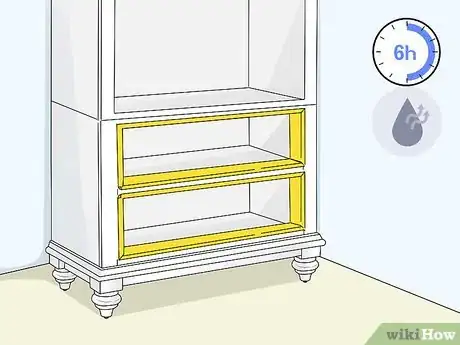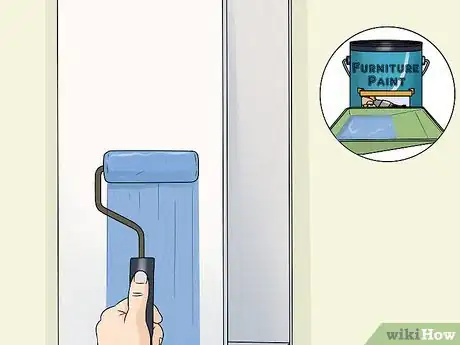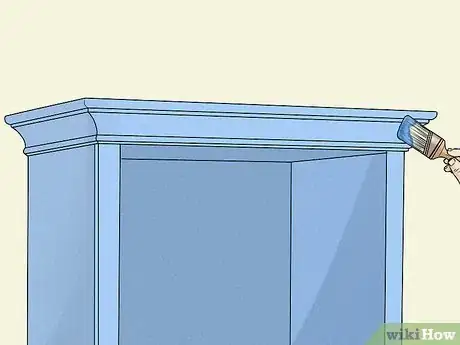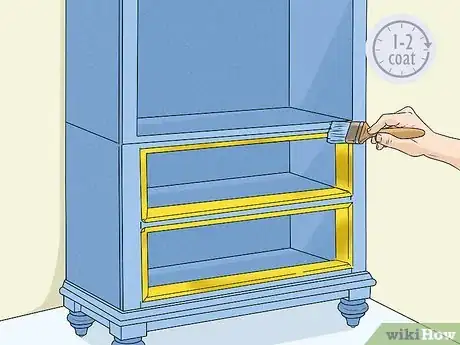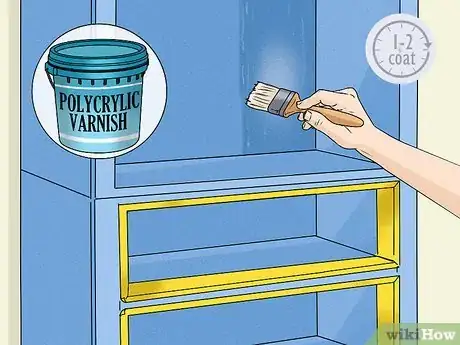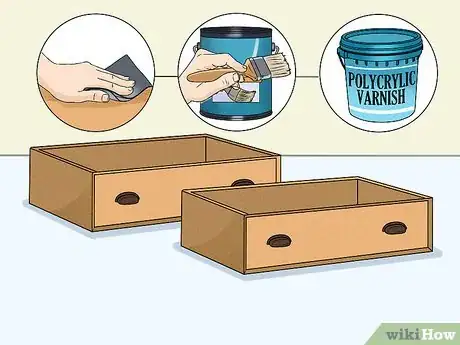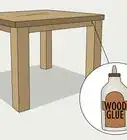This article was co-authored by Sarah Symonds and by wikiHow staff writer, Jessica Gibson. Sarah Symonds is a DIY Specialist, Blogger, and the Owner of The Grace In My Space Blog, a home decor, interior design, and DIY blog. With over five years of experience in DIY projects, she specializes in affordable home design focused on creativity and comfort. Sarah has been featured in numerous publications such as Better Homes and Gardens, Country Living Magazine, and American Farmhouse Style Magazine. She is also the author of Designing a Life: From House to Haven. Sarah holds an MS in Business Management from Cornerstone University.
There are 11 references cited in this article, which can be found at the bottom of the page.
This article has been viewed 15,006 times.
If you're tired of looking at an outdated wardrobe that no longer matches your bedroom style, it's time for a change! Fortunately, a new coat of paint can dramatically change the look of the piece. If you've painted wood before, you're probably familiar with sanding and priming the surface. Then, you can use a bold, new paint color to update your wardrobe. If you feel like really giving it a makeover, swap out the handles or pulls, too.
Steps
Sanding
-
1Move the wardrobe away from the wall and place a tarp around the bottom. If you can easily move the wardrobe, put it in a room with good ventilation. If you can't, don't worry! Just pull the wardrobe away from the wall and spread drop cloths on the floor to protect it from paint and sawdust. Then, open windows so you get good airflow.[1]
- Put on a dust mask and goggles before you start sanding and painting, so you don't breathe in fine sawdust or paint particles.
- Take a moment to make sure that the wardrobe is solid, too. Shore up any wiggle room in the joints with wood glue or screws to make sure that the construction is stable.[2]
-
2Remove hardware and doors from the wardrobe. Take a screwdriver and unscrew the hardware like handles, knobs, or pulls. Then, unscrew the hinges that hold the doors in the front of the wardrobe and take the doors off. Pop the small pieces into bags and set them aside so you don't lose them.[3]
- It's true that you can leave the doors on the wardrobe and paint around them, but you might miss tight spots.
- If your wardrobe also has drawers, pull these out before you sand.
Advertisement -
3Rub coarse sandpaper on the wardrobe to remove paint or stain. Take a coarse grit block that's between 40 and 80 grit and rub it back and forth across the entire wardrobe. Stop sanding once you can see the bare wood start to show.
- To save time or remove stubborn paint, you could use an electric sander or apply a chemical stripper. Keep in mind that chemical strippers are messy and often hard on the wood, so try this option if sandpaper isn't effective.[4]
-
4Sand the surface with medium-grit sandpaper to prep the surface. Switch to a medium-grit block that's between 80 and 120. Then, sand the wardrobe again. The medium-grit sandpaper removes more of the paint or stain and roughs up the wood so paint sticks to it easier.[5] [6]
- Don't forget to sand the doors and the drawers if your wardrobe has them.
-
5Wipe away the sawdust with a damp cloth and let the wardrobe dry. Dip a soft cloth into water and wring it out thoroughly. Wipe the wardrobe with the damp cloth to remove all of the powdery sawdust. Then, wait until the wood is totally dry before you start priming it.[7]
- Wipe the sanded doors and drawers, too.
- You can also clean off the furniture with soap and water or a trisodium phosphate solution.[8]
Priming
-
1Tape off areas of the wardrobe that you don't want to paint. If your wardrobe has drawers, you might not want to paint the inside of them, or there may be decorative edging that you want to paint in a different color. Tear off blue painter's tape and stick it onto any areas that you don't want to paint.[9]
- The tape also prevents paint from dripping down onto areas you don't want to paint like inside the drawers.
-
2Brush wood primer or multi-purpose primer onto the corners and details. Dip a 2 in (5.1 cm) paintbrush into the primer and brush it onto tight corners or decorative edges. Prime any tight spaces that will be hard to reach with a paint roller.[10] [11]
- It can be tempting to skip the primer, but it really helps your paint go on smoothly and it can prevent paint from peeling later on.
-
3Use a foam roller to apply primer to the flat surfaces. Pour primer into a clean paint tray and coat a foam roller in it. Then, use broad, even strokes to spread the primer over the sides, front, and frame of the wardrobe.
- To prime the doors, lay them flat on your tarp or drop cloth and prime 1 side at a time. Dry them for 4 to 6 hours before you flip them over and prime the other side.
-
4Wait 4 to 6 hours for the primer to dry before painting the wardrobe. Most primers dry faster than furniture paint, so if you prime the wardrobe in the morning, you can start painting it in the afternoon.[12]
Painting
-
1Buy furniture paint or oil-based paint in a satin or semi-gloss finish. Oil-based or furniture paint is more durable than latex paint, so it won't peel over time. Since your wardrobe will probably get regular use, pick a satin or semi-gloss finish since they're easy to clean and they won't show scratches, fingerprints, or everyday wear.[13]
- The paint color is what will really give your old wardrobe a new look, so don't be afraid to go bold. Paint an old wardrobe black or white if you want a big change or choose a bright color if you want to add interest to your room. Feel free to use chalk paint if your style is rustic or shabby chic—the choices are endless!
-
2Paint the large, flat surfaces with a paint roller. Pour your paint into a paint tray and dip a paint roller into it to load the roller. [14] Then, apply a thin, even coat onto the wide flat sides of the wardrobe. You can also use the roller to paint the inside of the wardrobe that's visible when you open the doors.[15]
- Don't forget to paint the doors too!
-
3Use a small paintbrush to paint edges or detailed parts of the wardrobe. Dip a straight or angled paintbrush into your paint tray and use it to paint areas that are tricky to reach with the roller. Paint around hinges, edges, feet, and detailed molding, for instance.[16]
- For really ornate or curvy details, you might want an even smaller brush so you can fit the bristles into tight spaces.
-
4Let the paint dry for 24 hours. Furniture paint or oil-based paint takes longer than standard latex paint, so plan on waiting 24 hours after the first coat before you apply the next coat of paint. Don't be tempted to hurry, or you might accidentally pull up the paint as you're trying to apply the next coat.[17]
-
5Apply another 1 to 2 coats to get uniform coverage. You'll still be able to see brush strokes after applying the first coat of paint, but don't worry.[18] Additional coats of paint hide these and bring out the rich color of your paint. If you're painting the wardrobe a dark color, it probably only needs 1 more coat, but lighter colors usually need 2 or 3 coats to get uniform coverage.[19]
- Remember to let the paint dry for 24 hours between each coat.
Finishing Touches
-
1Apply 1 to 2 coats of polycrylic varnish if you want to protect the wardrobe. Your wardrobe will probably get a lot of use, so varnish can protect the wardrobe and keep the finish looking great. Dip a clean paintbrush into polycrylic and brush it onto the wardrobe in long, even strokes. Then, wait about 1 hour before you apply another coat.[20]
- Avoid using polyurethane, which can turn yellow over time.
-
2Paint the hardware if you'd like to give wooden handles or pulls a new look. If the old wooden handles or pulls were painted, sand and prime the pieces just like you did for the wardrobe. Then, paint them the same color as the wardrobe if you'd like them to blend in, or pick an acrylic paint color that complements the wardrobe color.[21]
- For example, if you have a creamy, chalk-painted wardrobe, paint the handles black if you want them to stand out. If you have a dark navy blue wardrobe, you could paint the hardware a pale blue or white, for instance.
-
3Buy replacement hardware if you want to update the style of the wardrobe. New handles or pulls are a simple way to really change the overall look of your wardrobe. Pick out hardware that's comfortable and works with the style of the wardrobe.
- For instance, go with dark, matte black hardware if your wardrobe is a neutral color and you want the hardware to stand out.[22]
- Try brushed-nickel handles on a black wardrobe for a sleek, modern look.
- Add gold hardware if you have a pale wardrobe that you'd like to make a little glamorous.
-
4Wait at least 48 hours before you reinstall the hardware, drawers, and doors. Since wardrobes get a lot of wear and tear, let the paint cure completely before you reattach doors, hardware, and drawers. Give the paint at least 48 to 72 hours to completely dry and cure. Then, screw the hardware and doors back in place. If it has drawers, slide them back into the wardrobe.[23]
Expert Q&A
-
QuestionDo I really need to sand the wardrobe before painting?
 Sarah SymondsSarah Symonds is a DIY Specialist, Blogger, and the Owner of The Grace In My Space Blog, a home decor, interior design, and DIY blog. With over five years of experience in DIY projects, she specializes in affordable home design focused on creativity and comfort. Sarah has been featured in numerous publications such as Better Homes and Gardens, Country Living Magazine, and American Farmhouse Style Magazine. She is also the author of Designing a Life: From House to Haven. Sarah holds an MS in Business Management from Cornerstone University.
Sarah SymondsSarah Symonds is a DIY Specialist, Blogger, and the Owner of The Grace In My Space Blog, a home decor, interior design, and DIY blog. With over five years of experience in DIY projects, she specializes in affordable home design focused on creativity and comfort. Sarah has been featured in numerous publications such as Better Homes and Gardens, Country Living Magazine, and American Farmhouse Style Magazine. She is also the author of Designing a Life: From House to Haven. Sarah holds an MS in Business Management from Cornerstone University.
DIY Specialist Oh, for sure! Lightly sand or degloss the entire surface that you want to paint, as this will give the paint the best foundation to adhere to.
Oh, for sure! Lightly sand or degloss the entire surface that you want to paint, as this will give the paint the best foundation to adhere to. -
QuestionShould you seal wood after painting?
 Sarah SymondsSarah Symonds is a DIY Specialist, Blogger, and the Owner of The Grace In My Space Blog, a home decor, interior design, and DIY blog. With over five years of experience in DIY projects, she specializes in affordable home design focused on creativity and comfort. Sarah has been featured in numerous publications such as Better Homes and Gardens, Country Living Magazine, and American Farmhouse Style Magazine. She is also the author of Designing a Life: From House to Haven. Sarah holds an MS in Business Management from Cornerstone University.
Sarah SymondsSarah Symonds is a DIY Specialist, Blogger, and the Owner of The Grace In My Space Blog, a home decor, interior design, and DIY blog. With over five years of experience in DIY projects, she specializes in affordable home design focused on creativity and comfort. Sarah has been featured in numerous publications such as Better Homes and Gardens, Country Living Magazine, and American Farmhouse Style Magazine. She is also the author of Designing a Life: From House to Haven. Sarah holds an MS in Business Management from Cornerstone University.
DIY Specialist Yes, you definitely should! After applying your color of choice, seal it with a wax or a polyurethane coat for the best durability.
Yes, you definitely should! After applying your color of choice, seal it with a wax or a polyurethane coat for the best durability.
Things You'll Need
- Dust mask and goggles
- Drop cloth
- Screwdriver
- Old rags for cleanup
- Coarse, medium, and fine sandpapers
- Wood primer
- Foam roller
- Paint stirrers
- Paint tray
- Small paintbrush
- Blue painter’s tape, optional
- Polycrylic, optional
References
- ↑ https://www.theguardian.com/lifeandstyle/2010/jan/18/painting-furniture
- ↑ Sarah Symonds. DIY Specialist. Expert Interview. 29 September 2021.
- ↑ https://youtu.be/oYJRSYf0YQc?t=38
- ↑ https://www.bobvila.com/articles/how-to-refinish-a-dresser/
- ↑ https://www.bobvila.com/articles/how-to-refinish-a-dresser/
- ↑ Sarah Symonds. DIY Specialist. Expert Interview. 29 September 2021.
- ↑ https://www.apartmenttherapy.com/how-to-paint-a-wooden-dresser-apartment-therapy-tutorials-178977
- ↑ Sarah Symonds. DIY Specialist. Expert Interview. 29 September 2021.
- ↑ https://www.apartmenttherapy.com/how-to-paint-a-wooden-dresser-apartment-therapy-tutorials-178977
- ↑ https://www.apartmenttherapy.com/how-to-paint-a-wooden-dresser-apartment-therapy-tutorials-178977
- ↑ Sarah Symonds. DIY Specialist. Expert Interview. 29 September 2021.
- ↑ https://www.apartmenttherapy.com/how-to-paint-a-wooden-dresser-apartment-therapy-tutorials-178977
- ↑ https://www.bobvila.com/articles/best-paint-for-furniture/
- ↑ Sarah Symonds. DIY Specialist. Expert Interview. 29 September 2021.
- ↑ https://youtu.be/EVz7sT7B1dE?t=430
- ↑ https://youtu.be/EVz7sT7B1dE?t=568
- ↑ https://www.bobvila.com/slideshow/the-8-painting-mistakes-almost-everyone-makes-48420
- ↑ Sarah Symonds. DIY Specialist. Expert Interview. 29 September 2021.
- ↑ https://www.bobvila.com/slideshow/the-8-painting-mistakes-almost-everyone-makes-48420
- ↑ https://youtu.be/l3Sm-s_W2AU?t=1026
- ↑ https://www.apartmenttherapy.com/how-to-paint-a-wooden-dresser-apartment-therapy-tutorials-178977
- ↑ https://youtu.be/GJeauF4SKFQ?t=122
- ↑ https://www.apartmenttherapy.com/how-to-paint-a-wooden-dresser-apartment-therapy-tutorials-178977
